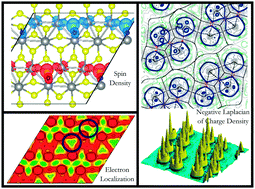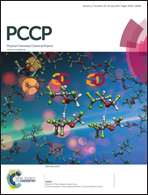Robust magnetic domains in fluorinated ReS2 monolayer†
Abstract
Transition metal dichalcogenides are layered materials that are typically bound together by van der Waals forces. An exception in the family is ReS2; the geometrical distortion of its lattice structure due to Peierls distortion dimerizes Re atoms to form zigzag chains, thus decoupling the layers electronically and vibrationally. This in turn reduces the layer dependence of its physical and chemical properties. In order to tailor the properties of ReS2 monolayer, an alternative way by fluorination above and between Re chains in the lattice is investigated. The results of density functional theory calculations show the site-dependent electronic properties of fluorinated ReS2: (i) F atoms above the Re chains induce metallic mid-gap states which are ferromagnetically-coupled within the Re chains, and antiferromagnetically-coupled between chains; (ii) F atoms between the Re chains induce semiconducting mid-gap states which are non-magnetic. Unlike other states observed, the mid-gap states associated with top sites above the Re chains are generally insusceptible to the external electric field. The electron localization and negative Laplacian plots show that not only bonds between F and S atoms are ionic in character, the Re chains are also coupled ionically. The emergence of these robust metallic mid-gap states in the localized domains suggest that electrons could conduct along the Re chains by hopping. The electron conduction in such functionalized ReS2 is anisotropic in nature, and hence could be applied in spintronic devices, such as spin-transfer torque and spin-wave logic devices.


 Please wait while we load your content...
Please wait while we load your content...